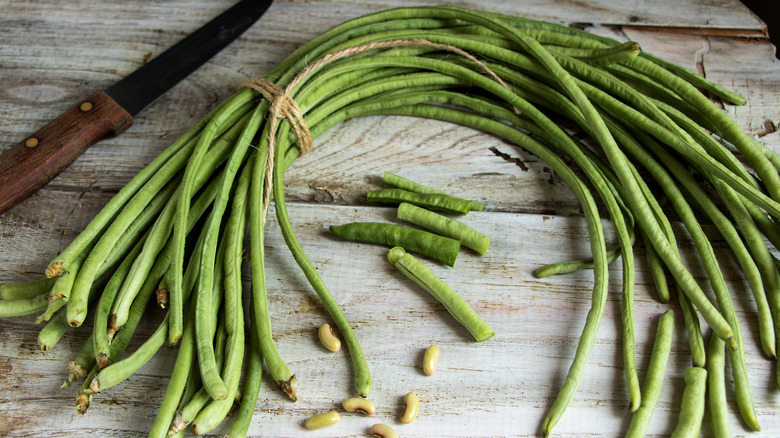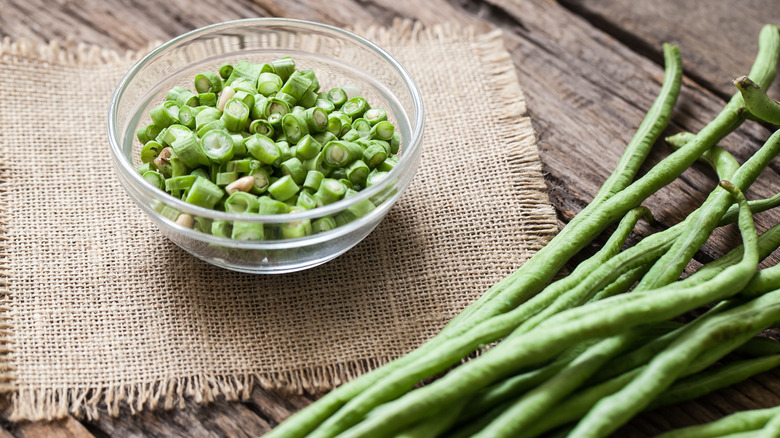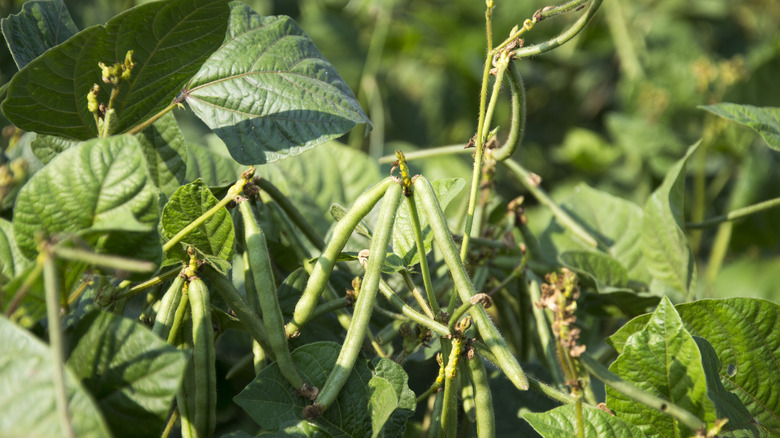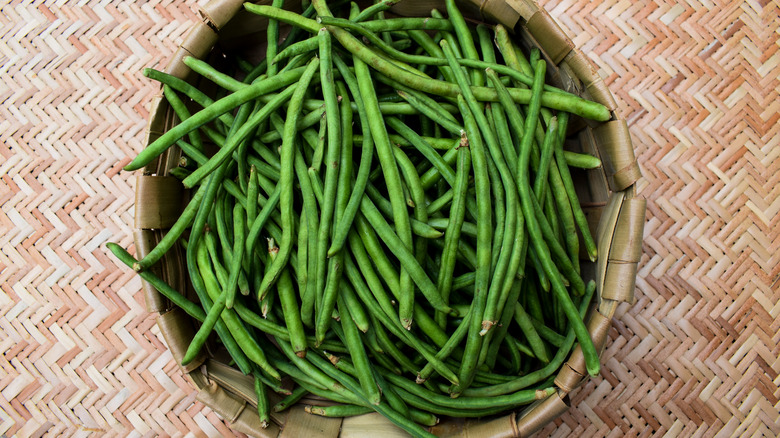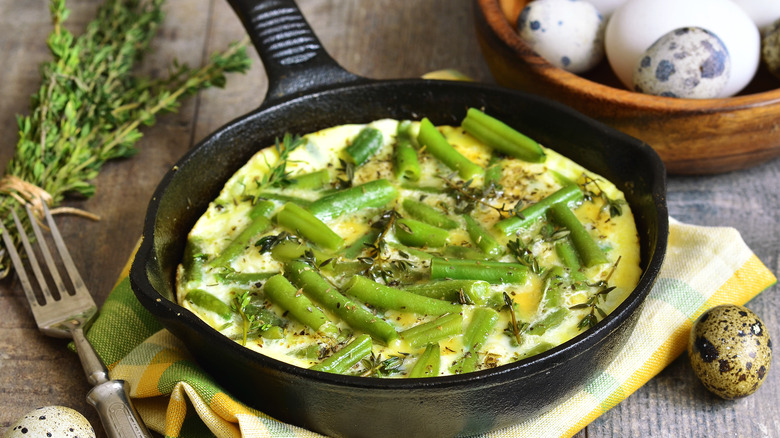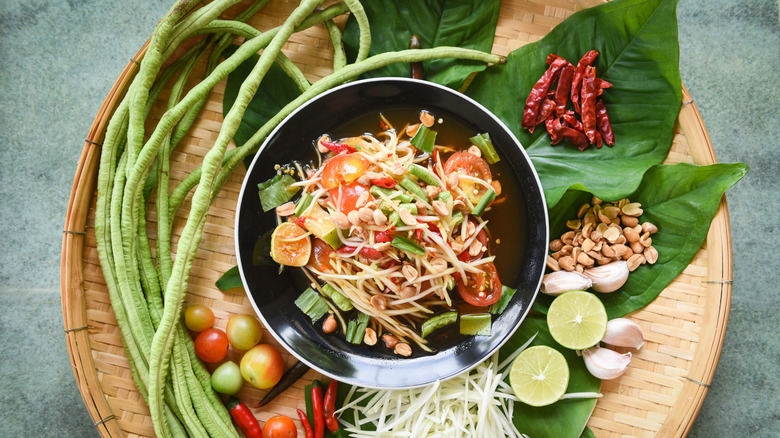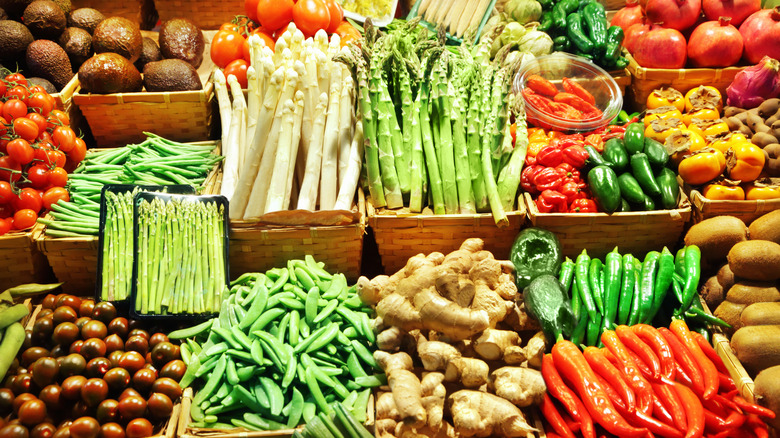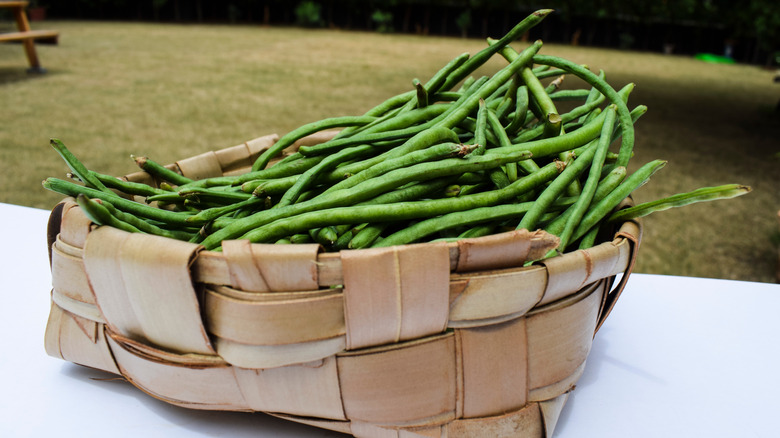What Are Yardlong Beans And How Do You Eat Them?
Beans are one of the most commonly consumed and vital foods. The United States Department of Agriculture cites legumes as the second most important plant family for humans, with grasses like rice and wheat being the most important for human survival. There are over 16,000 species of legumes worldwide, many of which you likely aren't even familiar with.
One species of bean you may not have encountered is the yardlong bean. These beans resemble traditional green beans in terms of color, but they're unique in their excessively long size, as the name suggests. Yardlong beans are a vining (or pole bean), annual type of bean, and native to Southeast Asia (via Echo Community). There's a lot more to yardlong beans than their size, though. Their taste and use in cooking, as well as their nutritional benefits, are exceptional and a little unique, but they still retain a classic legume flavor. Keep reading to learn more about this wonderful long bean variety.
What are yardlong beans?
Yardlong beans are very similar in appearance to traditional green beans, but they have their own unique place in both gardening and culinary spheres. As Echo Community explains, yardlong beans are a variety of cowpeas, also known as black-eyed peas. Yardlong beans are named for the length of the bean pods, which can get up to one yard in length. They're also interchangeably referred to as asparagus beans, snake beans, or dow gauk.
The long green legume is a very popular crop in Southeast Asia, and it's one of the Philippines' most commonly grown beans, reportedly referred to as "poor man's meat." That's not the extent of the legume's popularity, though, as it's also very prominent in southern China, Bangladesh, and Taiwan, as well as the Caribbean and in California. The bean pods are annual climbing legumes sought out for their similarity in flavor to green beans, but with an earthier, sweeter flavor, as described by Evergreen Seeds.
How are yardlong beans grown?
Yardlong beans are grown most commonly in tropical and subtropical climates in Southeast Asia, as explained by Evergreen Seeds. But they can be grown in any warm climate, or in a temperature-controlled greenhouse. The issue with growing yardlong beans as opposed to more common, moderate-temperature legumes is the germination process. At all stages of the growth process, the beans need to be kept in soil at no less than 60 degrees Fahrenheit, and ideally 80 to 90 degrees, including when sowing.
This is why they grow so well in warmer climates, but home gardeners have the ability to germinate and sow the seeds indoors and transfer them outside in the late spring. They're also sun-loving crops. The biggest notable factor about growing yardlong beans is that they like to climb. Gardeners tend to harvest the beans when they're young since they're firmer. The annual produces lots of beans once mature, so there's no shortage of produce to go around. Harvesting usually starts in the summer and lasts until mid-to-late fall.
Yardlong beans vs. green beans
Upon first glance, green beans and yardlong beans may not be too distinguishable from one another, aside from the obvious size difference. However, the two legumes have very distinct flavors and uses in cooking. They're also quite different in how they're grown. As Almanac explains, green beans can be grown either as vining plants (also known as pole beans, since they climb trellises or poles) or as a smaller, compact plant, also referred to as bush beans. Yardlong beans, on the other hand, are exclusively climbing plants (via Evergreen Seeds).
The size difference is also quite substantial. Average string beans typically only grow to be around 7 inches long at the most, whereas yardlong beans can grow to be anywhere from 1 to 3 feet in length. Yardlong beans are also an entirely different species and genus than green beans (per New Entry Sustainable Farming Project). The taste is another distinguishing factor — while most people are familiar with the crisp texture and bright flavor of green beans, yardlong beans are less firm and sweeter when raw, but lose some of that flavor when cooked.
What do yardlong beans taste like?
Yardlong beans are similar in appearance to green beans, and even slightly in flavor. However, yardlong beans are distinguished from other legumes in more ways than appearance and the growth process. As Small Kitchen Guide explains, these beans have a taste quite similar to asparagus, which is why they're sometimes referred to interchangeably as asparagus beans.
More than that, they're described as being unilaterally sweeter than green beans. While they still have a very earthy bean taste, the sweetness is a lot more present in long beans. Where other legumes like haricots are quite snappy and juicy, yardlong beans are described as being very meaty and chewy, notes Harvest to Table. While you could certainly swap out any other brighter bean for yardlong beans, the end result is going to be less bright and more dense, hearty, and rich. That dense nature makes it less favorable for long, hot cooks, boiling, or use in stews, warns Journal News. When steamed or heated like this, they usually become very floppy and lose their flavor. Instead, it's recommended to cook them in quick, high heat, like when pan frying or tossed in with fried rice.
How to cook with yardlong beans
While you could replace green beans for yardlong beans if it's all you have on hand, or vice versa, the two legumes aren't going to yield the same result. Green beans are a little brighter, earthier, and fresh, but yardlong beans are heartier, meatier, and dense, explains Journal News.
When cooking yardlong beans on their own, it's recommended to do so in a way that's quick so they retain their flavor and shape as much as possible. A simple way to serve them on their own is to cut them into small strips and pan-fry them with a flavorful oil like sesame, peanut, or sunflower on high heat for just a few minutes.
Harvest to Table recommends pairing yardlong beans with classic Southeast Asian flavors and ingredients to really highlight their sweet, meaty nature, such as ginger, garlic, soy sauce, fish sauce, chilis, vinegar, and pork. New Entry Sustainable Farming Project has a recipe for eggs and yardlong beans spiced with cumin, chili peppers, fresh curry leaves, and onion — a delicious and flavorful way to start your morning.
Where to buy yardlong beans
Where you should look for yardlong beans depends on where you live. If you have access to supermarkets with a diverse selection of produce or live in a warmer climate, you're naturally going to have a higher chance of finding yardlong beans in stock with the rest of the legumes. Since they're largely a Southeast Asian crop, though, you may have better luck checking out your local Asian grocery store. Regardless of where you buy them, you'll have the best luck finding them in the summer and fall.
Don't get caught up on the name, either. While yardlong beans is what they're often called, the legume is also referred to as the asparagus bean, long bean, Chinese long bean, snake bean, dau gok, or bodi, notes Harvest to Table. The long shape will be pretty hard to miss among the array of shorter beans, though.
When looking for the freshest, best yardlong beans, look for a solidly green-colored pod. If it's gone yellow or white in color, it's too ripe. Even among truly green yardlong beans, there's some variety. Lighter green beans will have a sweeter, heartier taste and a softer, more tender texture, whereas darker yardlong beans will have a much stronger, more potent taste and be firmer in texture. The pod should be smooth, too. If the beans are bulging or breaking out of the pod, pass them along in favor of a smoother bean.
Nutritional information about yardlong beans
Yardlong beans are a great addition to your fridge — not just for their great flavor, but also for their nutritional benefits. Legumes are a staple in many people's diets for their general health benefits, including protein, fiber, and iron (per Medical News Today). Yardlong beans are certainly no exception.
According to Check Your Food, the average serving size of yardlong beans is 70 grams, or nearly 2.5 ounces. Within these 70 grams, yardlong beans contain 33 calories, 6 grams of carbohydrates, and 2 grams of protein. The beans are also rich in lots of daily nutrients. A serving of yardlong beans has 43.4 micrograms of folate, which helps with energy, mental health, and immune health, as well as 2.66 grams of fiber for smooth digestion, 30.8 milligrams of magnesium for energy and bone health, 0.075 milligrams of vitamin B1 for heart health and energy, 7 milligrams of vitamin C for immune and bone health and energy, 41.3 milligrams of phosphorus for cell functionality, and 3.71 milligrams of quercetin for kidney, liver and heart health.
